Input interpretation

acetyl chloride
Chemical names and formulas
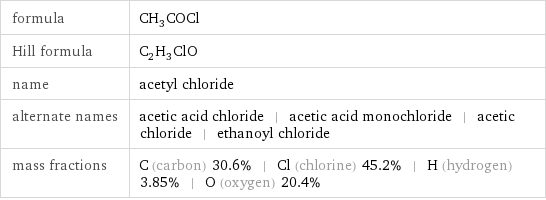
formula | CH_3COCl Hill formula | C_2H_3ClO name | acetyl chloride alternate names | acetic acid chloride | acetic acid monochloride | acetic chloride | ethanoyl chloride mass fractions | C (carbon) 30.6% | Cl (chlorine) 45.2% | H (hydrogen) 3.85% | O (oxygen) 20.4%
Lewis structure
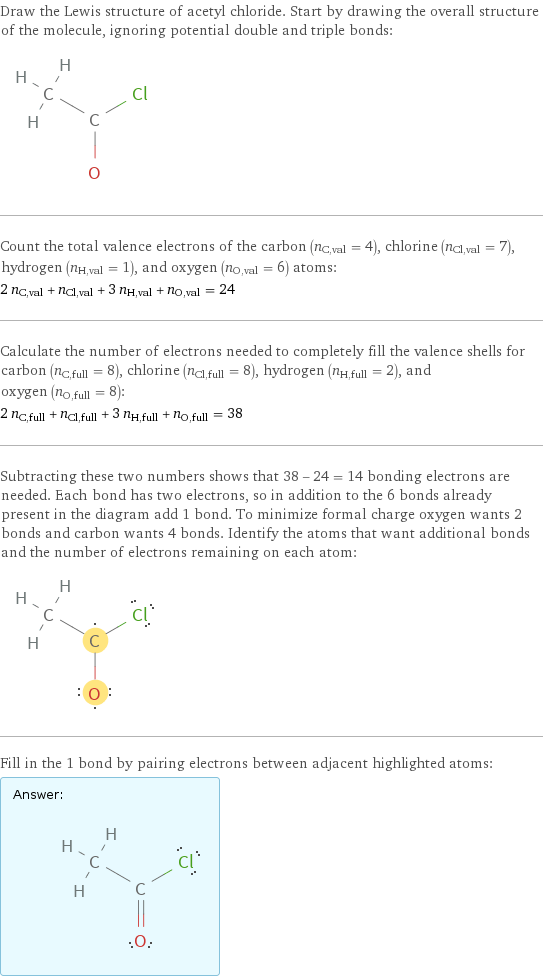
Draw the Lewis structure of acetyl chloride. Start by drawing the overall structure of the molecule, ignoring potential double and triple bonds: Count the total valence electrons of the carbon (n_C, val = 4), chlorine (n_Cl, val = 7), hydrogen (n_H, val = 1), and oxygen (n_O, val = 6) atoms: 2 n_C, val + n_Cl, val + 3 n_H, val + n_O, val = 24 Calculate the number of electrons needed to completely fill the valence shells for carbon (n_C, full = 8), chlorine (n_Cl, full = 8), hydrogen (n_H, full = 2), and oxygen (n_O, full = 8): 2 n_C, full + n_Cl, full + 3 n_H, full + n_O, full = 38 Subtracting these two numbers shows that 38 - 24 = 14 bonding electrons are needed. Each bond has two electrons, so in addition to the 6 bonds already present in the diagram add 1 bond. To minimize formal charge oxygen wants 2 bonds and carbon wants 4 bonds. Identify the atoms that want additional bonds and the number of electrons remaining on each atom: Fill in the 1 bond by pairing electrons between adjacent highlighted atoms: Answer: | |
3D structure

3D structure
Basic properties
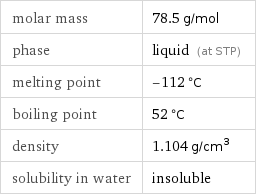
molar mass | 78.5 g/mol phase | liquid (at STP) melting point | -112 °C boiling point | 52 °C density | 1.104 g/cm^3 solubility in water | insoluble
Units

Liquid properties (at STP)
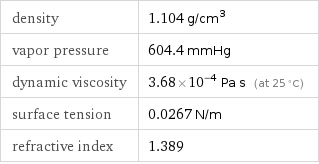
density | 1.104 g/cm^3 vapor pressure | 604.4 mmHg dynamic viscosity | 3.68×10^-4 Pa s (at 25 °C) surface tension | 0.0267 N/m refractive index | 1.389
Units

Thermodynamic properties
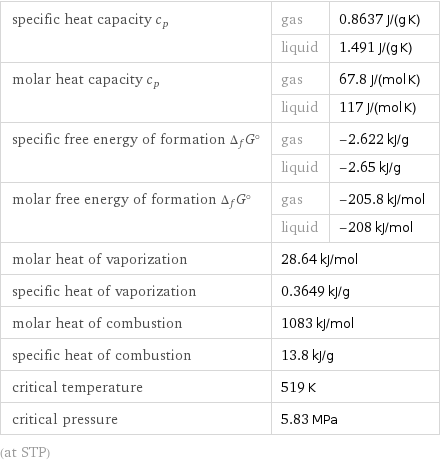
specific heat capacity c_p | gas | 0.8637 J/(g K) | liquid | 1.491 J/(g K) molar heat capacity c_p | gas | 67.8 J/(mol K) | liquid | 117 J/(mol K) specific free energy of formation Δ_fG° | gas | -2.622 kJ/g | liquid | -2.65 kJ/g molar free energy of formation Δ_fG° | gas | -205.8 kJ/mol | liquid | -208 kJ/mol molar heat of vaporization | 28.64 kJ/mol | specific heat of vaporization | 0.3649 kJ/g | molar heat of combustion | 1083 kJ/mol | specific heat of combustion | 13.8 kJ/g | critical temperature | 519 K | critical pressure | 5.83 MPa | (at STP)
Chemical identifiers
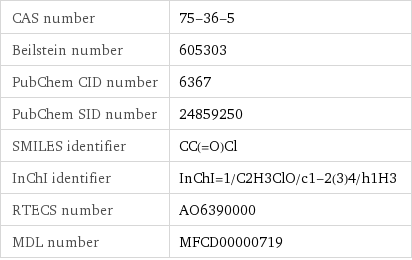
CAS number | 75-36-5 Beilstein number | 605303 PubChem CID number | 6367 PubChem SID number | 24859250 SMILES identifier | CC(=O)Cl InChI identifier | InChI=1/C2H3ClO/c1-2(3)4/h1H3 RTECS number | AO6390000 MDL number | MFCD00000719
NFPA label

NFPA label
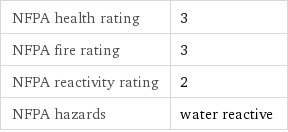
NFPA health rating | 3 NFPA fire rating | 3 NFPA reactivity rating | 2 NFPA hazards | water reactive
Safety properties
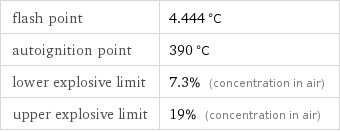
flash point | 4.444 °C autoignition point | 390 °C lower explosive limit | 7.3% (concentration in air) upper explosive limit | 19% (concentration in air)

DOT hazard class | 3 DOT numbers | 1717
Toxicity properties

RTECS classes | mutagen | human data